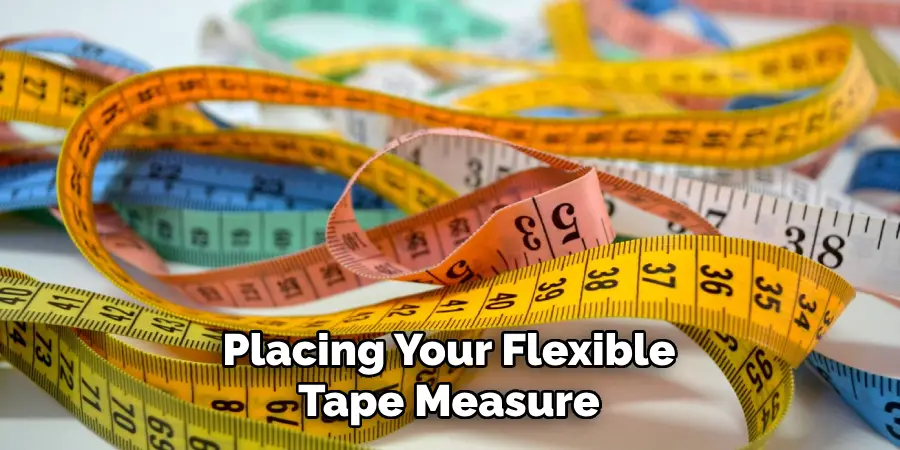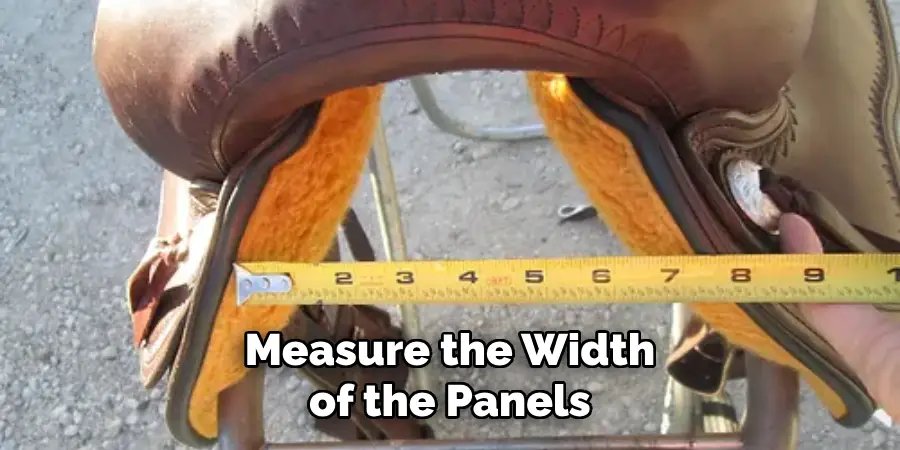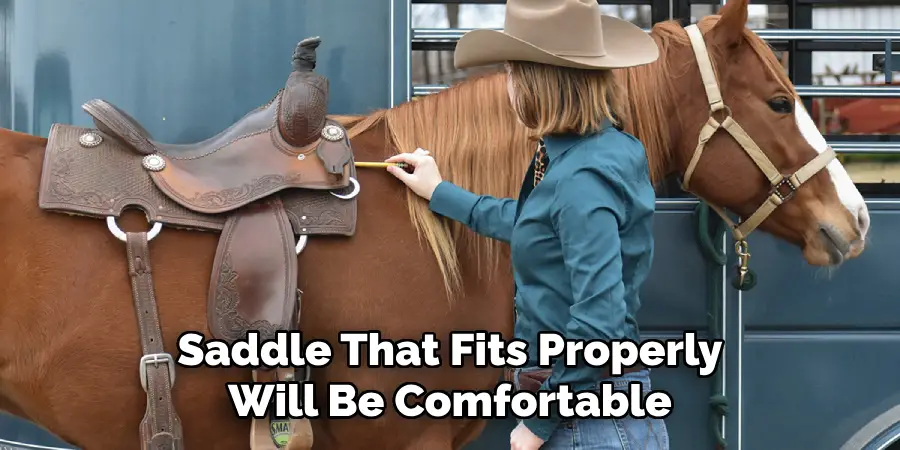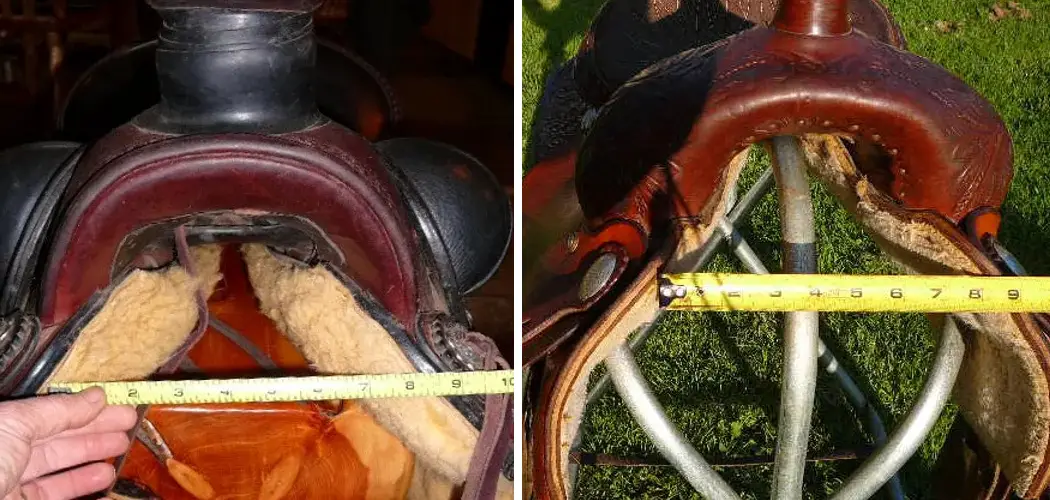Do you ever find yourself wondering how to measure the gullet on a saddle? If you need to check if your saddle’s fit is right for your horse, then follow these easy steps and get back in the saddle with confidence.

Taking careful measurements of your saddle and understanding its components can help ensure that the fit is just right. From checking how wide the gullet should be based on your horse’s body width to ensuring adequate clearance above their withers, here are some tips for How to Measure the Gullet on a Saddle of a western or English-style tack.
What is Gullet on a saddle?
A saddle’s gullet refers to the space at the center of the tree between its pommel (front) and cantle (back). The gullet affects how a saddle fits your horse.
On western saddles, it is measured from one side of the tree to the other. On English-style saddles, it is usually measured across the widest point of the saddle, which is usually the panels.
Knowing your saddle’s gullet width is important for finding a saddle that fits you and your horse well. Gullets on saddles vary in size and shape, so it’s important to measure before buying.
Necessary Materials
Given below is a list of materials that you need for measuring the Gullet on a saddle:
- A Flexible Tape Measure
- Pen and Paper to Take Notes
- Saddle to Measure
10 Step-by-step Guidelines on How to Measure the Gullet on a Saddle
Step 1: Measure the Gullet Width
Start by placing your flexible tape measure across the widest point of the gullet on either side of the tree (on western saddles). On English saddles, measure the widest point of the panel. Record this number in your notes. It is important to measure the saddle in its current state, as it may be different than the manufacturer’s specifications.

Step 2: Measure the Depth of the Gullet
Now slide your tape measure down the center of the tree from pommel to cantle and record this number in your notes. This will give you an idea of how deep the gullet is. This can also be useful for checking the clearance of your saddle over your horse’s withers. It is important to make sure that the gullet has enough clearance for your horse’s withers.
Step 3: Measure the Withers Clearance
To measure the withers clearance, insert your hand into the gullet and push your fingers up against the tree. Measure from where your hand touches to the bottom of the panels on either side. This will give you an indication of the amount of clearance your saddle offers over your horse’s withers.
Step 4: Measure the Gullet Angle
To measure the gullet angle, place a ruler on top of the panels and measure from one side to the other at a 45-degree angle. Record this number in your notes as it may be useful for comparing different saddles. However, this is not an exact measurement and should only be used as a reference point.
Step 5: Measure the Panel Width
Measure the width of the panels at their widest point and record this measurement in your notes. This is important for ensuring that you are getting a saddle with enough room for your horse’s back. If the panels are too narrow, it may restrict their movement. But if the panels are too wide, it may create pressure points.

Step 6: Measure the Tree Points
Once you have recorded the general measurements of your saddle, it is important to measure the tree points. To do this, place a ruler underneath the panels and measure from the center point of the gullet to each side of the tree (on western saddles). Record these numbers in your notes.
Step 7: Measure the Cantle Height
Finally, measure the cantle height by placing a ruler along the inside edge of the cantle and measuring from where it meets the tree to its highest point. Record this number in your notes as well. This will help to ensure that the saddle fits your horse’s back properly and that you are able to achieve a comfortable riding position.
Step 8: Compare Your Measurements
If you have access to the manufacturer’s specifications for your saddle, compare your measurements to those listed. If the measurements are significantly different, it may be a sign that the saddle is not fitting properly or has been altered in some way. It is important to ensure your saddle fits properly before using it.
Step 9: Check for Flaws
The last step is to check carefully for any flaws or damage to the saddle. This includes checking for cracks in the tree and signs of wear in the leather. Pay particular attention to any areas where the tree has been altered, as these could affect the fit of your saddle. You should also check the stitching and buckles for any signs of wear.
Step 10: Adjust or Replace Your Saddle
If you find that your measurements are significantly different than the manufacturer’s specifications, it may be time to look for a new saddle or have yours adjusted. A saddle that fits properly will be comfortable for both you and your horse, so take the time to ensure it’s just right before heading out on the trail.

Now that you know how to measure the gullet of a saddle, you are ready to find one that’s just right for your horse. Whether you’re looking for a Western or English-style saddle, the information you’ve gathered will help you make an informed decision. Don’t forget to check for flaws and wear before buying—it could save you time and money in the long run!
Following these simple steps on how to measure the gullet on a saddle will help you properly measure the gullet on a saddle and ensure that it is fit for your horse’s needs. With careful measurements, you can be sure that the saddle you choose will provide optimum comfort for both you and your horse. Be sure to follow these guidelines when searching for your next Western or English-style ride!
Frequently Asked Questions
Q1: How Do I Know if the Gullet on My Saddle is Too Wide?
A1: The best way to know if the gullet on your saddle is too wide is to measure it and compare it with the manufacturer’s specifications. If your measurements are larger than the specified size, then it may be too wide for your horse. Additionally, you can check the clearance over your horse’s withers to make sure there is enough space.
Q2: What if I Don’t Have Access to the Manufacturer’s Specifications?
A2: If you don’t have access to the manufacturer’s specifications, you can compare your measurements to those of other saddles. Additionally, if you are unsure of the size and fit, it is best to consult with a local saddle fitter who will be able to advise you on what size and type of saddle would be best for your horse.
Q3: What If I Can’t Find My Saddle’s Manufacturer’s Specifications?
A3: If you cannot find your saddle’s manufacturer’s specifications, it may be helpful to contact the company directly. They should be able to provide you with detailed information on the measurements and construction of your particular saddle.
Additionally, if you are still unsure of the size and fit, it is best to consult with a local saddle fitter who will be able to advise you on what size and type of saddle would be best for your horse.

It is important that you take the time to measure your saddle’s gullet correctly in order to ensure it fits your horse properly. By following these steps, you can make sure your saddle provides maximum comfort for both you and your horse.
Conclusion
All in all, measuring the gullet of your saddle is a very important process to ensure that your horse rides comfortably and safely. When measuring the width and angle of the gullet, it is important to take the measurements from several spots along the saddle to ensure accuracy.
It is also essential to measure the length of your horse’s withers in order to determine which sized saddle tree you should purchase.
In addition, when looking at saddles, always check for signs of wear or damage that could interfere with your horse’s safety during riding. Finally, never be afraid to ask a certified saddle fitter for help if you are unsure about how to go about measuring or finding the right fit!
By following these guidelines on how to measure the gullet on a saddle, you can rest assured that your horse will have just the right size and shape of the saddle for them, leading to more enjoyable rides in both comfort and safety.
You Can Check It Out to Clean Leather Saddle

